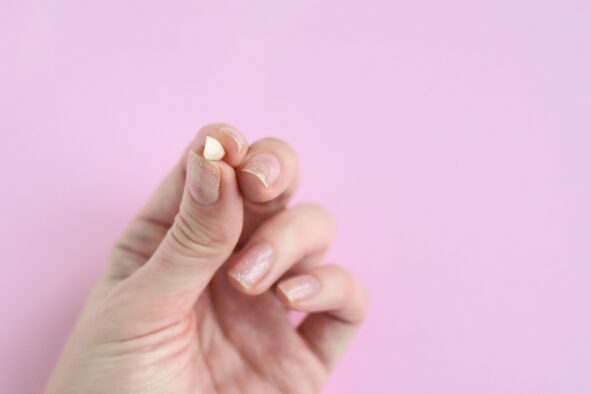Are you tired of consciously sticking your tongue at something sharp in the middle of your teeth? Or have you been experiencing discomfort days after going through an oral procedure? Stop wondering what it is because clearly, you’ve been fighting a bone spur in gum.
In the beginning, people with bone spurs may only notice a mild soreness or irritation in the affected area. But when the condition advances, symptoms may worsen and cause tingling or even pain in certain areas, as well as make it uncomfortable to talk or chew.
In this article, we have compiled all the information you may need about this condition, starting from what a bone spur in mouth really is, down to its causes and treatment. Let’s dive in…
What are dental bone spurs?
A dental bone spur is a sharp bone sticking out of gum that forms along the jawbone or inside the mouth cavity. It is sometimes referred to as oral bone spur or oral exostoses.
These can appear on the palate, the insides of the cheeks and lips, or as a bone spur on jaw bone. Even though they are usually harmless and not cancerous, they can nevertheless be uncomfortable and could indicate more serious dental problems.
Tooth bone spur on gums may feel rough or harsh when touched. Sometimes they can be seen with the naked eye, and other times they might only be found using dental imaging, including X-rays or CT scans.
Many people with dental bone spurs may not show any symptoms at all, but some may feel pain or irritation, especially when speaking, eating, or using oral appliances.

Are dental bone spurs serious?
Dental bone spurs can vary in seriousness depending on some factors, such as size, location, and whether they are producing symptoms or restricting oral function. Dental bone spurs frequently go unnoticed and are only accidentally discovered during routine imaging or dental checkups.
On the other hand, dental bone spurs may need to be treated if they irritate, hurt, or interfere with oral function. For instance, if left untreated, bone spurs that rub against the tongue’s or mouth’s soft tissues can be uncomfortable and raise the risk of infections or ulcers.
In this case, it’s advisable to incur a dental bone spur removal cost rather than letting it worsen your oral health.
Rarely, underlying dental disorders including gum disease or ill-fitting dental appliances may also be linked to dental bone spurs. It could be essential to take care of these underlying problems to stop bone spurs or other complications from returning.
Seeing a dentist for examination and treatment can help reduce discomfort and take care of any underlying problems.
What causes bone spurs in mouth?
Weird enough, bone spurs in mouth can be caused by more reasons than one. However, the 3 main reasons behind the cause of bone spurs are as follows:
Poor dental care
Poor dental care can lead to the formation of bone spurs in the gums. This is mainly because of the conditions and behaviors that are linked to poor dental care, which can cause persistent irritation and damage to the oral tissues.
One of the most common consequences of poor dental care is Periodontitis, another name for gum disease. When plaque and tartar build-up along the gum line as a result of insufficient brushing and flossing, bacteria can multiply and cause gum inflammation and infection.
If left untreated, gum disease can eventually cause the gums to recede and reveal the bone tissue underneath. Periodontitis-related chronic inflammation can promote abnormal bone growth, which may result in the development of bone spurs in the gums.
Dental implants
Despite being a very successful tooth replacement option, dental implants sometimes promote the growth of bone spurs in gums. While bone spurs caused by dental implants are a rare occurrence, many factors related to the implantation procedure and the recovery that follows may play a role.
Dental implant placement involves a surgical process in which an implant post— which functions as a substitute tooth root— is placed into the jawbone.
While this practice is largely safe and well-accepted, it still involves trauma to the surrounding bone tissue. Gums and neighboring bone may sustain localized damage and inflammation as a result of the surgical incision, implant site drilling, and bone manipulation during implant insertion.
The healing process of the surrounding bone and gums from the trauma caused by the dental implant may play a role and trigger the growth of a bone spur in gum.

Tooth extraction
Bone spurs in the gums can also result from tooth extraction which is a common procedure of tooth removal to treat different dental problems. Also known as oral exostosis, this condition can arise from several causes related to the extraction procedure and the healing that follows.
After a tooth has been extracted, the bone tissue in the socket left by the extracted tooth goes through a process called Alveolar bone resorption. In this process, the bone tissue that originally supported the tooth gradually loses its structure.
The alveolar bone around the tooth may eventually start to resorb or shrink if the roots of the tooth aren’t stimulating the area. Consequently, the remaining bone tissue may acquire imperfections or rough surfaces, which could serve as locations for the development of bone spurs after extraction.
The body’s capacity to recover itself can be hampered by things like infection, insufficient blood flow, or damage to the surrounding tissues during the extraction procedure.
Because of this, the bone tissue at the extraction site might not heal completely or might break apart, creating abnormalities in the surface of the bone that could encourage the growth of bone spurs.
Bone spur symptoms
If you’ve been affected with a bone spur in gums, you might experience the following symptoms:
- Pain that worsens with pressure and movement
- Swelling and inflammation in surrounding tissues
- Tenderness in surrounding gums
- Difficulty with jaw and nearby muscle movement
- Clicking, popping, and grinding sensations during movement

How to treat tooth bone spur on gums
In order to treat a dental bone spur on the gums, you must treat the underlying source of the spur as well as any accompanying symptoms.
Consult with professional dentists for diagnosis and treatment if you think you may have a tooth bone spur on your gums. Dentists are best qualified to validate the diagnosis, evaluate the spur’s intensity, and suggest the best course of action.
Topical analgesic gels or creams available over the counter can help reduce pain and discomfort brought on by a dental bone spur in the gums. To temporarily numb the region and lessen pain, apply the gel directly to the affected area as instructed by the manufacturer.
Dental operations could be required in certain conditions to treat a dental bone spur. To reduce inflammation and stop additional damage to the surrounding tissues, your dentist could advise smoothing or reshaping the spur.
If conservative treatments are ineffective, and the spur is causing severe discomfort, or it is obstructing oral function, surgical excision of the spur may be required.
How to remove bone fragment from gums at home
You should not attempt to remove any sort of bone fragments at home, regardless of where it is. That said, there are preventions you can learn to deal with a bone spur in gum. Keeping your teeth clean is essential to controlling a tooth spur and avoiding problems. Use a soft-bristled toothbrush and fluoride toothpaste to brush your teeth twice a day.
Floss your teeth every day to get rid of food particles and plaque. Maintaining good dental hygiene can aid in halting more inflammation and discomfort near the spur.
The area around a dental bone spur may become more painful and irritated when certain meals and drinks, such as spicy or acidic foods, are consumed. To avoid more discomfort, wait until the spur has healed before consuming these items.
Rinse your mouth many times a day with warm salt water to aid in healing and reducing inflammation. Combine a teaspoon of salt in a glass of warm water. Swish the mixture around your mouth for approximately 30 seconds, then spit it out.
If the region around the spur is swollen or inflamed, place an ice pack or cold compress wrapped in a cloth on the outside of your cheek and hold it there for brief periods. This may offer momentary relief by numbing the region and reducing swelling.
FAQ
The answer to this depends on many factors such as the size, location, and symptoms related to the bone fragment. In some cases, if your bone spur isn’t causing pain or interfering with your mouth’s functions, it doesn’t require any intervention. But bigger or troubling bone spurs might warrant a trip to the dentist’s office!
In some cases, bone spurs in your mouth will come out on their own, just like bone spurs on different parts of the body! It’s important that you don’t put force on the bone spur to come out as this can aggravate the problem. However, in some cases, you might have to visit a dentist if the bone spur is painful and get professional advice.
Final Thoughts
In conclusion, even if they sometimes persist silently, bone spurs in the mouth can pose some challenges for oral comfort and health and managing these dental anomalies efficiently requires knowledge of their causes, symptoms, and possible treatments.
We invite you to Premiere Dental for personalized oral solutions and top notch professional treatment. Our team of highly qualified experts is committed to providing extensive dental services that are customized to meet your specific requirements.
Make an appointment at Premiere Dental now to see the difference for yourself.


